For a long time, artists portrayed dinosaurs in the drab grays, greens, and browns of most reptiles. This changed around 15 years ago, when Jakob Vinther, a paleontologist at the University of Bristol, discovered pigment-containing cell structures, called melanosomes, in fossilized dinosaur feathers.
In 2010, Jakob Vinther and his colleagues completely reconstructed the color of Anchiornis, a small, winged dinosaur, based on the shape of fossilized melanosomes in its feathers.
Mike DiGiorgio
Vinther came up with a method to predict dinosaur colors based on how the creatures’ melanosomes appeared under the microscope—whether they looked like sausages, meatballs, something in between, or entirely different. In 2010, his team completed the first-ever dinosaur color reconstruction: According to their estimates, the bird-like Anchiornis was mostly gray, save for its black-and-white banded wings and striking mohawk-like reddish brown crest.1
Since then, Vinther and others have used this approach to predict how other dinosaurs, as well as various prehistoric animals, looked and even how they lived.2,3 While the public embraced their discoveries with open arms, some paleontologists still question whether Vinther’s technique has enough rigor. To this day, these scientists hold fast to their stance that one simply cannot deduce how animals look, behave, and evolve from their melanosome shape alone.
Old, Solidified Squid Ink Inspired Dinosaur Color Discoveries
Vinther never planned on studying dinosaurs. As a graduate student at Yale University, he wanted to understand the origin of animals by applying molecular biology techniques to well-preserved fossils.
“Sometimes, you make discoveries when you’re not trying to make a discovery,” he said.
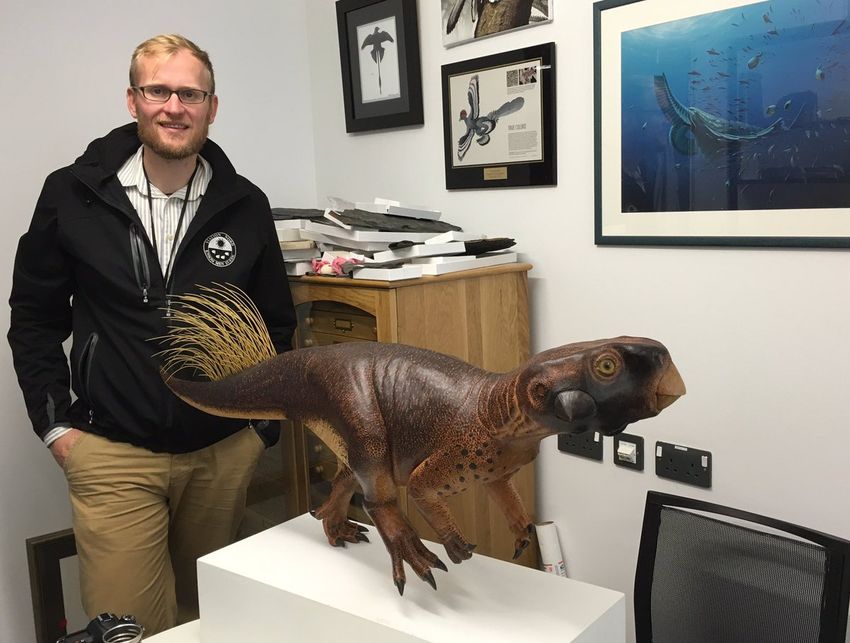
Jakob Vinther, a paleontologist at the University of Bristol, came up with a method to predict dinosaur colors based on melanosome shapes.
Jakob Vinther
In 2006, Vinther, then in the first year of his PhD program, enrolled in a course on exceptional fossil preservation. He was tasked to figure out why squid ink is liquid in a living animal but fossilizes into a solid lump, instead of simply disintegrating. “I never worked that out, actually,” Vinther said. “But what I discovered was that the ink was really well preserved.”
When Vinther studied squid ink under a microscope, he observed dark, round balls that were a few hundred nanometers in diameter. It didn’t matter if the ink came from freshly caught squid or fossils that were hundreds of millions of years old—the structures looked virtually identical.
The microscopic balls’ extraordinary preservation impressed Vinther. He wondered if they were melanosomes, which would contain the pigment melanin, and if the melanin was the same as the kind found in human hair, skin, and eyes. “We don’t really know whether the melanin is still melanin, but we can see that these balls that contain melanin, are intact,” Vinther said, explaining why he decided to focus on the balls themselves (melanosomes) rather than their contents (melanin).
Vinther thought, if melanosomes indeed persist for hundreds of millions of years, maybe they can help researchers figure out the colors of extinct animals, such as dinosaurs. But “when I first presented the idea, everyone thought I was just going off on a whim,” Vinther said. “Even my supervisor [paleontologist Derek Briggs] was a little bit like, ‘Yeah, right, whatever.’”
To test if melanosomes could indeed fossilize, Vinther searched for fossils of animal body parts that are known to contain melanosomes, such as the feathers of modern birds, dinosaurs’ direct descendants. In the meantime, he scoured published studies to learn what melanosomes look like in these samples. From the literature, Vinther gathered that bird feather melanosomes that mostly contain black melanin (eumelanin) are elongated like sausages, while those consisting mostly of the red-and-yellow “ginger” melanin (phaeomelanin) are round like meatballs.
To test his hypothesis further, Vinther secured the fossil skull of a small bird that had an eye and some of its feathers preserved from his home country, Denmark. “I started zooming in on this electron microscope, and there was just this ocean of aligned sausages,” he said.
Briggs was still unimpressed, so he and Vinther consulted Richard Prum, an evolutionary biologist at Yale University who studies bird colors. “[Prum] said, ‘These look like melanosomes to me,’ and that’s when [Briggs] got excited about it,” Vinther recalled.
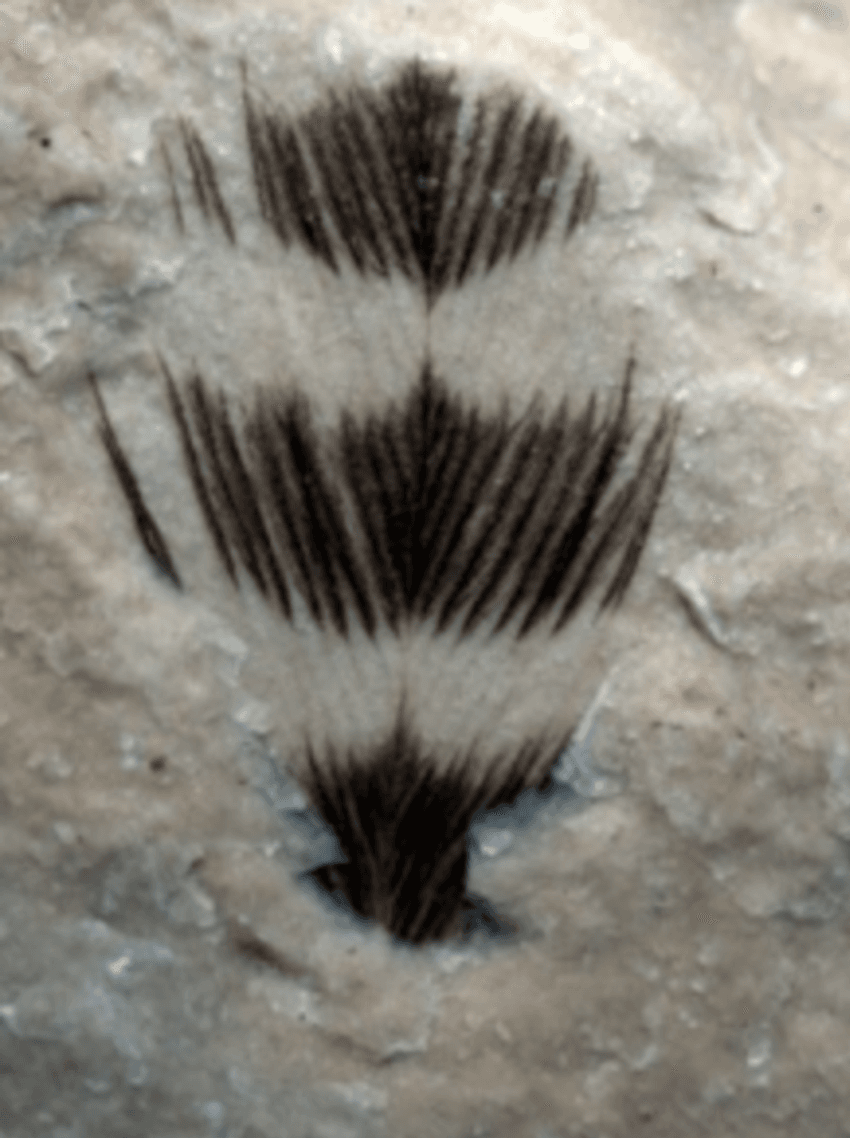
Vinther analyzed an approximately hundred-million-year-old bird feather and observed that melanosomes lined the black, but not white, bands. This gave him and Briggs the confidence that they might be able to figure out the color of dinosaurs.
Jakob Vinther
As a proof-of-concept study, Briggs advised Vinther to analyze an approximately hundred-million-year-old bird feather with distinct black-and white bands under a microscope.4 Briggs and Vinther hypothesized that they would see sausage-like melanosomes line the black, but not white, bands. This was exactly what Vinther found when he looked under the microscope.
He said, “We thought that this would be the thing to convince people. That was when we said, ‘We can put colors on dinosaurs.’”
Melanosome-Based Dinosaur Color Predictions Took Wing
In 2008, Chinese paleontologists were unearthing large quantities of fossils of Anchiornis, a small, winged dinosaur that lived around 150 million years ago—many of which also had well-preserved feathers. Vinther’s team took advantage of this abundance of samples, which does not happen often in paleontology.
To determine Anchiornis’s color, the researchers sampled 29 feathers from different parts of the dinosaur’s body, performed a statistical analysis which compared the melanosomes in these feathers to those in living birds, and then clustered them based on similarity. The analysis quantified a trend that Vinther had observed by combing through literature.
Based on the results, the researchers postulated that most of Anchiornis’s body was gray, its wings had a banded black-and-white pattern, and the crest atop its head was reddish brown. This not only revealed what the long-gone creature might have looked like, but it also suggested that animals had likely started using colorful displays to communicate with each other—the way modern birds do—since the time of the dinosaurs.
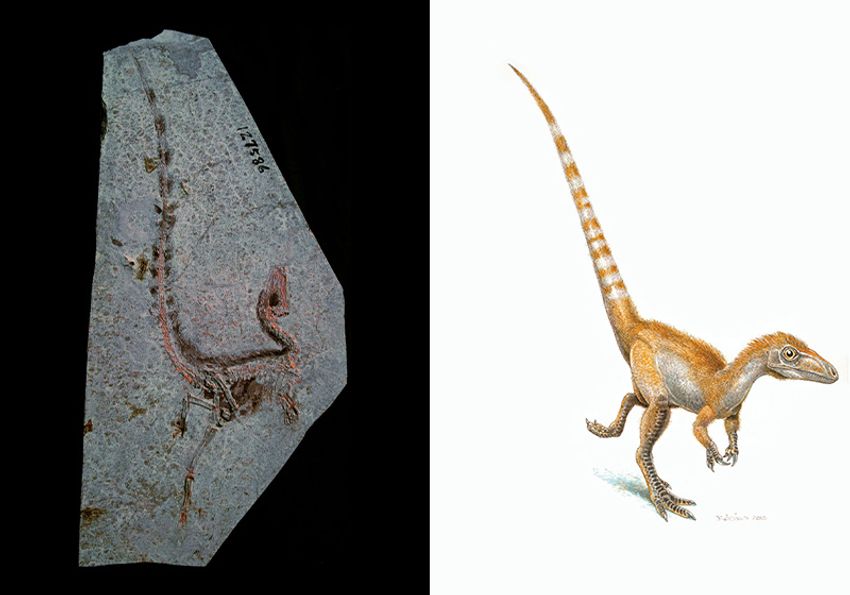
One of the dinosaurs that Benton analyzed in his 2010 Nature paper was Sinosauropteryx, which likely had ginger feathers.
Mike Benton
Vinther’s team was not the only one puzzling out dinosaur colors. Another group, led by Mike Benton, a paleontologist at the University of Bristol, had noticed Vinther’s earlier work with the old, black-and-white bird feather and decided to test his findings. Benton analyzed fossilized feathers from an extinct bird and two dinosaurs that his group was already studying.5
“We suddenly learned that somebody else decided to do the same thing, and we were a little bit in competition with them,” Vinther said. “It’s both stressful and quite exhilarating.”
In 2010, the two studies were published within a week of each other—Vinther’s in Science and Benton’s in Nature. Benton did not attempt a full-body color reconstruction of either dinosaur or the bird, but he confirmed Vinther’s findings that the shape and arrangement of melanosomes in fossils could likely predict animal colors.
“I think people were mainly convinced pretty quickly,” Benton said, noting that in 2019, his discovery and Vinther’s were celebrated as one of the decade’s top ten scientific discoveries.
But not everyone was on board.
Melanosomes or Microorganisms? Artificial Fossilization Experiments Suggest the Former
Mary Schweitzer, a paleontologist at North Carolina State University, is one of Vinther’s most vocal critics. Schweitzer thinks that the fossilized structures that Vinther believes were melanosomes were actually bacteria.
Vinther was not the first to find roundish, melanosome-like shapes in old fossils. Paleontologists who came before him, including Briggs, had reported seeing similar structures in fossils and interpreted them as bacteria.6 According to Schweitzer, results from Vinther’s microscopy experiments—at least those in his early works—were severely lacking.
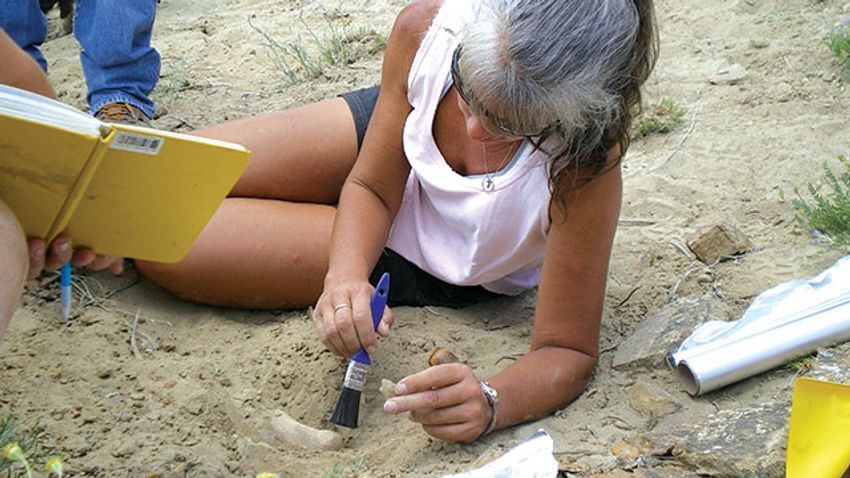
Mary Schweitzer, a paleontologist at North Carolina University, doubts the validity of melanosome shape-based dinosaur color reconstructions.
Kenneth Lacovara
“It was just like, ‘These things are morphologically similar to melanosomes, therefore they are,’” said Schweitzer. “If I had done that with my work, I would be embarrassed.”
Schweitzer and her colleagues argued that the shape, size, and arrangement of melanosomes and microbes on feathers are virtually indistinguishable.7,8 They pointed out that Vinther needed to perform chemical analyses, for example, using mass spectrometry, to corroborate his findings.
But Vinther was quite sure that he was looking at melanosomes. He reasoned that the structures only appeared where melanosomes likely existed, such as in the eyes and pigmented areas of the feathers, whereas “there should be bacteria all over the animal.”
In response to Schweitzer’s scathing review of his work, Vinther plotted the size of melanosomes from hundreds of animals, including dinosaurs, and compared these to the bacteria from Schweitzer’s study.9 He showed that the bacteria were much larger, both in length and diameter, refuting Schweitzer’s claim. Vinther also noted that bacteria rarely fossilize, although there are a few exceptions noted in the literature.10
A key piece of evidence supporting melanosome fossilization came from Maria McNamara, a paleontologist at University College Cork. When McNamara was a postdoctoral fellow at Yale University working with Briggs, she performed an artificial fossilization (also known as maturation) experiment, in which she exposed melanosome-bearing bird feathers to high pressure and temperature.11 McNamara observed that melanosomes could indeed fossilize, but the process significantly altered the organelles’ morphology.
“We realized that this would have impacts on the color reconstructions because the measurements of precise geometry were being used in color determination,” McNamara said.
A few years later, Vinther, who had moved to the University of Bristol, conducted a similar study, in which he artificially fossilized melanin and melanosomes from various body parts of different animals.12 He investigated the appearance of melanosomes under a microscope and the chemical properties of melanin using a minimally destructive approach called time-of-flight secondary ion mass spectrometry (TOF-SIMS). He then compared these features between fresh and artificially matured samples, as well as fossils.
The TOF-SIMS data revealed that fossilization, whether natural or artificial, altered melanin’s chemical profile. But Vinther also observed that artificial fossilization altered melanosome shape, just like McNamara reported. He even found that in some cases, this change occurred to a point beyond recognition. He posed that maturation experiments may not accurately portray the conditions by which fossils naturally form and maintained that melanosome shape is a reliable metric to infer melanin-based colors.
Benton agreed. “[The melanosomes] may lose a little bit of water and shrink a little bit, but on the whole, they pretty much keep their shapes. I think people are reasonably comfortable with that.”
But not Schweitzer and McNamara.
Don’t Judge a Dinosaur by Its Pigment Containers, Some Say
“I have absolutely no problem with the idea that the structures can persist, but I don’t think you can say what a dinosaur’s colors were based on the shape of these little organelles alone,” said Schweitzer.
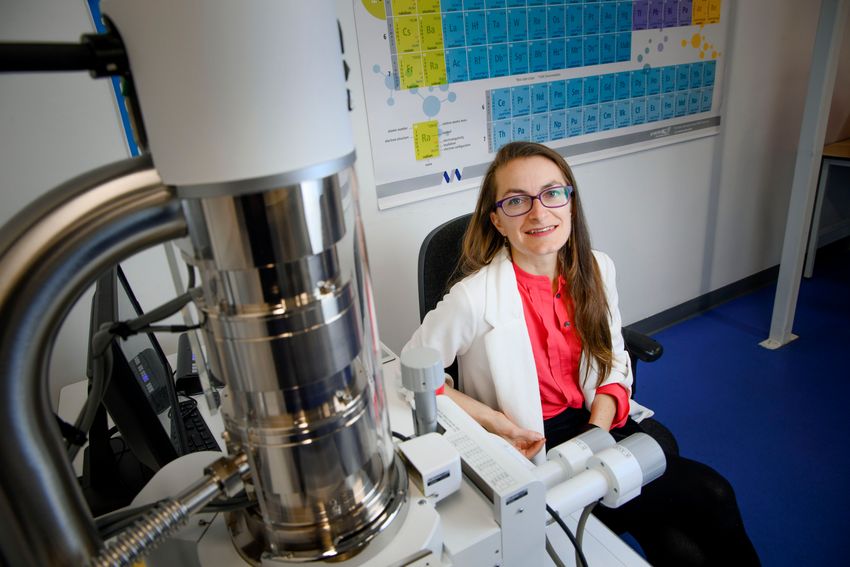
Maria McNamara is a paleontologist at University College Cork who studies the preservation of ancient biomolecules, such as melanin. Her work supported that melanosomes could fossilize, but like Schweitzer, she questions whether the organelles’ shape is a reliable proxy for dinosaur color.
University College Cork
McNamara agreed. “The bigger issue is whether shape is an appropriate proxy for color at all. We don’t really know for sure what link there is, if any, between the shape of a melanosome and its chemistry—it’s just a guess.”
McNamara referred to a 2019 study in which Vinther quantified the accuracy of the method he used to predict feather colors based on melanosome shapes—he reported a humble 62 percent.13 McNamara said, “For any other scientific study, we need to get to 95 percent [confidence] before we believe our stats. Are we so desperate to see what a dinosaur looks like that we’re willing to accept [this]?”
Vinther countered that not all samples had equally low accuracy. According to him, the model could predict black and reddish-brown well, though it was less confident in samples that fell somewhere along the spectrum of melanosome morphology. For instance, it had trouble distinguishing gray from some shades of blue—these colors arise from melanosomes that are both wide and long. The latter, also known as non-iridescent structural colors, form when melanosomes absorb light scattered by other microscopic structures in feathers, such as air pockets.
“I can agree that we need to do more work to improve this,” Vinther said. “But I don’t agree that we can’t predict colors in fossils based on the work we have done.”
The Future May Hold an Expanded Palette of Dinosaur Colors
Schweitzer still holds fast to her idea that the current approach to reconstruct dinosaur colors is subpar. She is open to the possibility that future work could lead to new color insights, though she remains cautious. “Do I think we’ll ever know for sure what color dinosaurs were? I think we can tell in part, but I don’t know how rigorously we’ll ever be able to say that,” she said.
Despite her skepticism, Schweitzer thinks that the lost world was likely filled with more color than scientists have discovered so far. “If the only pigments that were part of a dinosaur’s overall look were melanin-based, it was a very black-and-white universe back then, and I don’t think that was the case.”
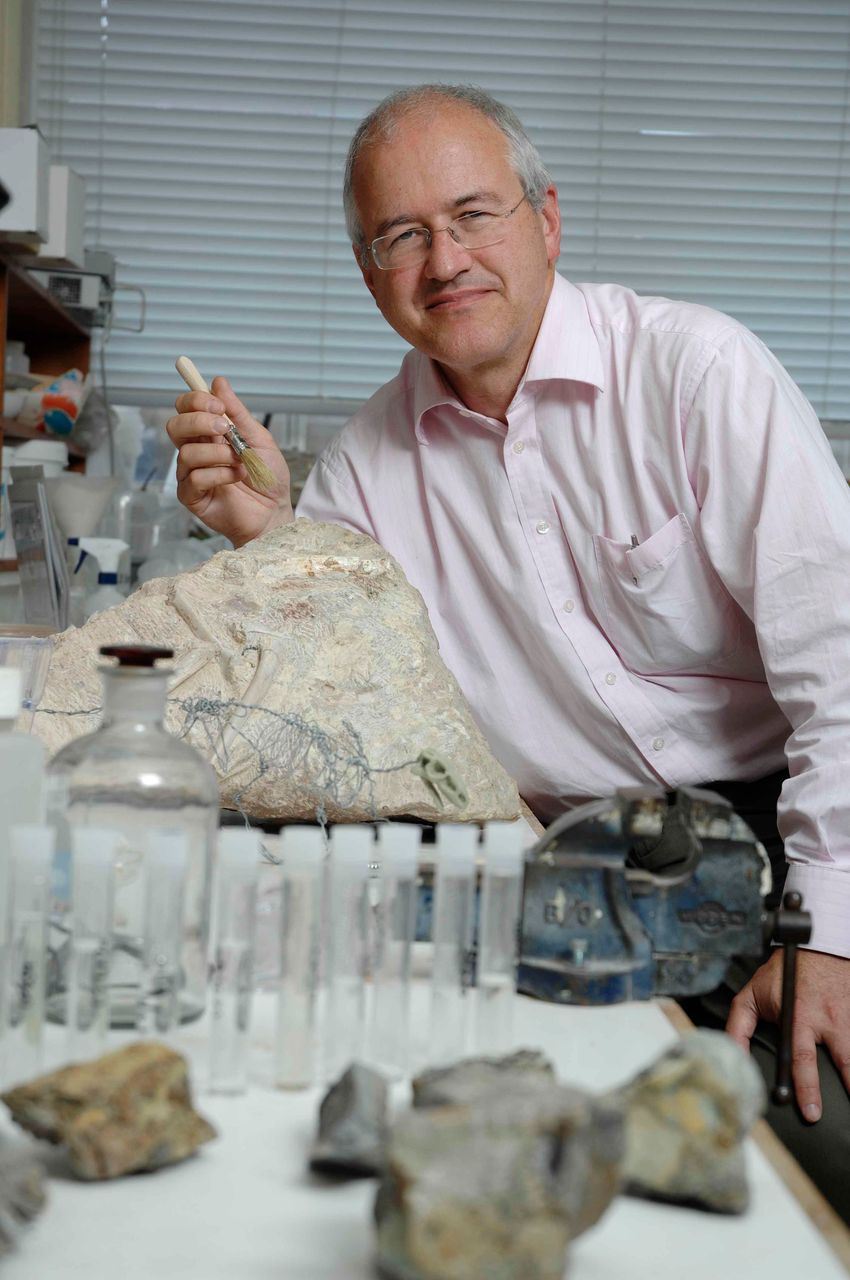
Mike Benton is a paleontologist at the University of Bristol who studies dinosaur evolution. In 2010, Benton’s paper analyzing melanosomes in fossilized feathers was published nearly concurrently with Vinther’s.
Mike Benton
On a similar note, McNamara said, it’s “very possible” that researchers will find evidence of other pigments besides melanin. This bright-colored future may not be too far away, as Vinther shared that he is currently “putting some colors on a dinosaur that is quite colorful,” although the study is still under wraps.
Benton, on the other hand, who has been a proponent of the field from the very beginning, thinks that there is still a lot more to be done when it comes to improving analytical techniques to study fossilized pigments and related structures. He said that in the future, “people may find better ways to do proper chemical analyses that people are confident in.”
To get there, Schweitzer encourages paleontologists to read the literature from fields beyond paleontology. “Without people actively looking at new technologies and how they can apply to dinosaurs, the field is going to stagnate.”
She recognizes that merging paleontology with molecular biology can feel like an uphill battle, but she remains optimistic.
“I think that molecular paleontology is going to continue to grow—I hope it does,” said Schweitzer.
- Li Q, et al. Plumage color patterns of an extinct dinosaur. Science. 2010;327(5971):1369-1372.
- Cincotta A, et al. Pterosaur melanosomes support signalling functions for early feathers. Nature. 2022;604(7907):684-688.
- Li R, et al. Mesozoic mammaliaforms illuminate the origins of pelage coloration. Science. 2025;387(6739):1193-1198.
- Vinther J, et al. The color of fossil feathers. Biol Lett. 2008;4:522-525.
- Zhang F, et al. Fossilized melanosomes and the colour of Cretaceous dinosaurs and birds. Nature. 2010;463(7284):1075-1078.
- Davis PG, Briggs DEG. Fossilization of feathers. Geology. 1995;23(9):783-786.
- Moyer AE, et al. Melanosomes or microbes: testing an alternative hypothesis for the origin of microbodies in fossil feathers. Sci Rep. 2014;4:4233.
- Schweitzer MH, et al. Melanosomes and ancient coloration re-examined: A response to Vinther 2015. Bioessays. 2015;37(11):1174-1183.
- Vinther J. Fossil melanosomes or bacteria? A wealth of findings favours melanosomes: Melanin fossilises relatively readily, bacteria rarely, hence the need for clarification in the debate over the identity of microbodies in fossil animal specimens. Bioessays. 2016;38(3):220-225.
- Lozano RP, Rossi C. Exceptional preservation of Mn-oxidixing microbes in cave stromatolites (El Soplao, Spain). Sediment Geol. 2012;255-256:42-55
- McNamara ME, et al. Experimental maturation of feathers: implications for reconstructions of fossil feather colour. Biol Lett. 2013;9(3):20130184.
- Colleary C, et al. Chemical, experimental, and morphological evidence for diagenetically altered melanin in exceptionally preserved fossils. Proc Natl Acad Sci U S A. 2015;112(41):12592-12597.
- Babarović F, et al. Characterization of melanosomes involved in the production of non-iridescent structural feathercoloursand their detection in the fossil record. J R Soc Interface. 2019;16(155):20180921.

